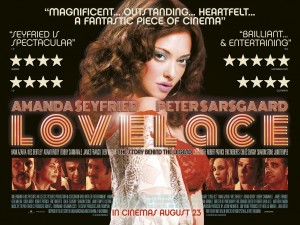LOVELACE: 2 STARS
 For a brief period in the mid-1970s the name Linda Lovelace lived at the very center of popular culture, particularly if the alphabetical listings in your movie collection weighed heavily toward the XXX.
For a brief period in the mid-1970s the name Linda Lovelace lived at the very center of popular culture, particularly if the alphabetical listings in your movie collection weighed heavily toward the XXX.
We first meet Linda Boreman (Amanda Seyfried) as a naïve twenty-year old, living at home with her strict parents (Sharon Stone and Robert Patrick). Her ticket out of the oppressive household is Chuck Traynor (Peter Sarsgaard), a strip club owner who sweeps her off her feet, marrying her just six months after they first met at the Moonlight Rollerway.
He’s a charmer until an IRS audit for tax fraud throws his life into a downward spiral. To crawl out from under the weight of debt he sells Linda into pornography, accepting $1250 to showcase her special sexual skills in a film called “Deep Throat.”
The ploy worked. The film became a sensation with everyone from Walter Cronkite to Johnny Carson and Bob Hope commenting on about it on television. Called the “Gone with the Wind” of pornography, the movie grossed an estimated $600 million and made Linda, now renamed Lovelace, the “postergirl for the sexual revolution.”
With success, however, came humiliation, physical and sexual abuse and a loss of personal identity.
Based on Linda’s tell-all “Ordeal,” “Lovelace” should be a cautionary tale, warning of the dangers of controlling spouses among others things, but plays more like a semi-raunchy Movie of the Week.
There are some good performances. Seyfried hits a career high, playing Lovelace as a vulnerable, innocent and fragile woman swept away by an obsessive man who tries to pass off sexual violence as passion.
Sarsgaard hams it up as Traynor, the wild-eyed psycho who, in one scene takes out his anger on a blow up effigy of Linda. He’s a bad man, but too broadly played to be truly convincing.
Solid supporting work from a who’s-who of indie film—Juno Temple, Chris Noth and Hank Azaria, among others—impresses, but Sharon Stone, unrecognizable as Linda’s cruel mother, is a stand out.
The film’s period details grab the look of the time—Crushed velvet jackets! Flares! Shirts open to the navel!—and archival news footage sets a tone, but it’s all veneer. The script, which features not one but two “6 Years Later” title cards, is relatively linear in its telling of the tale, but relies on big moments rather than insight to get its point across. With so many damaged people on display, it would have been interesting to explore how a man like Chuck can come to dominate those around him.
Documentary filmmakers turned feature directors Rob Epstein and Jeffrey Friedman also invert the First Rule of Cinema, “show me, don’t tell me,” loading up scene after scene with unnecessary exposition. In one superfluous scene a radio announcer begins an interview with the words, “This film has become a phenomenon,” seconds after a montage visually showed us the movie’s success.
“Lovelace” attempts to tell an edgy personal story, but squanders good performances from Seyfried, Stone and supporting cast, in a movie that is too, simplistic, too tame and too timid to do justice to Lovelace’s horror story.
